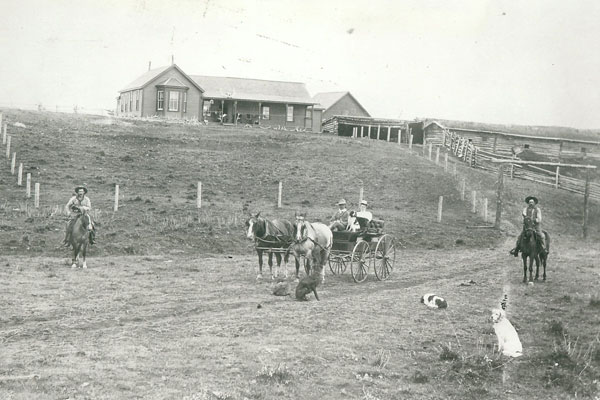
Ranching on the Jumping Pound
When John A.?W. Fraser built his XC Ranch at Jumping Pound Creek, Alta. in 1892, he had two specific goals in mind. He wanted to develop an efficient breed of cattle specifically suited to the native grasses and climate of the Canadian prairies, and he wanted to reduce livestock losses from disease. His attempts to do so led to major contributions in improving livestock on ranches across Western Canada, and he is also remembered for the innovative health techniques he introduced to the region.
Fraser was born in Scotland in 1868 and attended the Colonial College Agricultural School in Suffolk, where he graduated with a solid background in animal science. He arrived in Western Canada in 1890 and took up a homestead in the Cochrane, Alta., area on what later became known as the Merino Ranch. Although the land provided good grazing, it was not quite what he was looking for. In 1892 however, he found the right area for a permanent ranch in the lee of the Rocky Mountains near Jumping Pound.
Fraser knew after riding through the rolling grassland of the area that it was well suited to raising cattle and horses, so he purchased eight sections of range land. He described it as “situated in the Rockies with some mountain streams, bush on one side for winter range and open undulating prairie on the other for summer grazing and hay land”.
Fraser dropped his original JAW brand that year and took up the XC, which gave the name to his ranch. The ample grass, water and Fraser’s ability with livestock soon produced a good profit for his efforts and he also found time to court and get married. Unfortunately soon after his marriage his wife became ill and passed away. In 1903 he married his second wife, Muriel Winter and they had two daughters, Daphne and Diana.
An experimentalist at heart, Fraser began his ranch initially with imported Highland cattle, then switched to Shorthorns and finally built up a Shorthorn-Angus cross bred herd of 1,000 head. He also maintained a herd of 150 Suffolk sheep primarily to feed his hay crews during haying. Fraser was concerned about the high losses of livestock due to blackleg; in England inoculation had proved effective and he successfully pioneered the same methods in the Cochrane area.
Fraser was an excellent horseman and in 1902 he wanted to improve his horses. Most of the local horses were small so he imported Lord Nelson, the first Suffolk Punch stallion to be brought into Alberta. The Punch is one of the work horse breeds native to Great Britain and its bloodlines can be traced back to the 1500s. These horses were one of the first types to be used on road coaches in England and today they are still regarded as ideal working stock, combining longevity with excellent dispositions. Fraser used the stallion on his lighter weight mares to produce a heavier hunter type that was popular for work, driving and riding.
The native horse stock of the XC, although small in stature, wintered well and passed on traits of endurance needed on the range. The stallion gave extra size and heavier bone, producing a taller, stocky horse suitable for ranch work. News of his breeding program sparked the interest of the Canadian government and after viewing his herd of about 300 horses they awarded Fraser a government remount contract for the Mounties, and later for overseas service during WWI. It was with regret however, in later years, that Fraser learned of the suffering endured by horses involved in combat during the war.
One of Fraser’s best friends was Ted Cook, who was also the foreman of the XC Ranch. Sporting a wide sweeping moustache, flame red hair and a temper to match, Cook had been a farrier sergeant in the Boer War and was known for settling disputes with his fists. Fraser had to step in more than once to break up a bare knuckles brawl that had erupted between Cook and someone else over some difference of opinion. However, Fraser explained that even though Cook was quick to throw a punch, he was also responsible enough to be trusted with the task of organizing the men and horses to defend the ranch against its greatest summer enemy?—?wind driven prairie fires.
In 1919 the Calgary Stampede was held once again following WW1 and the Texas Longhorn steers used at the Stampede were wintered at the XC. This created a great deal of interest and many people came out to the ranch to view this historic cattle breed.
That fall Fraser sold the XC and moved with his family to Victoria B.C. He became restless and they moved back to the U-C Ranch in southern Alberta in the spring of 1920. Later the same year pioneer rancher John Fraser retired once more to Vancouver Island, remaining there until he died in 1930.
















